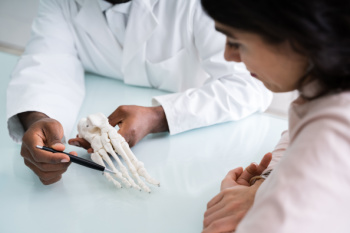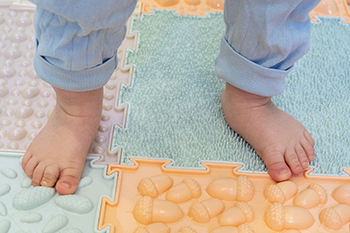August 2024
How a Podiatrist Can Help You

A podiatrist is a medical specialist focused on diagnosing and treating conditions related to the feet, ankles, and lower legs. These professionals are trained to handle a wide range of issues, from common problems like bunions and heel pain to more complex conditions such as fractures, diabetic foot care, and toe deformities. Visiting a podiatrist offers several benefits. They provide expert evaluations and tailored treatment plans for various foot and ankle concerns, ensuring accurate diagnoses and effective management. Podiatrists are skilled in performing surgeries, prescribing medications, and recommending targeted exercises to alleviate pain and improve mobility. They also offer preventive care and education to help avoid future problems. For those individuals with chronic conditions, such as diabetes, a podiatrist plays an important role in preventing complications by regularly monitoring foot health and providing specialized care. If you have any foot issues, it is suggested you schedule an appointment with a podiatrist who provides comprehensive, specialized treatment to maintain optimal foot and ankle health.
If you are dealing with pain in your feet and ankles, you may want to seek help from a podiatrist. Feel free to contact Joseph D. Ruffo, DPM, PC from New York. Our doctor can provide the care you need to keep you pain-free and on your feet.
What Is a Podiatrist?
A podiatrist is a doctor of podiatric medicine who diagnoses and treats conditions of the foot, ankle, and related structures of the leg. Your podiatrist may specialize in a certain field such as sports medicine, wound care, pediatrics, and diabetic care. Podiatrists have the ability to become board certified through training, clinical experience, and then taking an exam.
What Do Podiatrists Do?
On a daily basis, a podiatrist may perform the following activities:
- Diagnose foot ailments such as ulcers, tumors, fractures, etc.
- Use innovative methods to treat conditions
- Use corrective orthotics, casts, and strappings to correct deformities
- Correct walking patterns and balance
- Provide individual consultations to patients
It is very important that you take care of your feet. It’s easy to take having healthy feet for granted, however foot problems tend to be among the most common health conditions. Podiatrists can help diagnose and treat a variety of feet related conditions, so it is crucial that you visit one if you need assistance.
If you have any questions please feel free to contact one of our offices located in Sea Cliff and Babylon, NY . We offer the newest diagnostic and treatment technologies for all your foot and ankle needs.
Ankle Pain While Walking

Ankle pain while walking can stem from various causes. Common culprits can include sprains, arthritis, tendonitis, and fractures, all of which can result in inflammation, swelling, and discomfort. Overuse, wearing improper footwear, and previous injuries can also contribute. Ankle pain impacts mobility and quality of life, making walking difficult. To avoid ankle pain, wear supportive shoes, maintain a healthy weight, and perform exercises to strengthen ankle muscles. Rest, compression, and elevation can help manage pain. However, if you have persistent or severe ankle pain, it is suggested that you schedule an appointment with a podiatrist who can provide a proper diagnosis and a treatment plan. Regular check-ups with a podiatrist ensure ongoing foot and ankle health, allowing walking to remain a simple and effective means of transportation without discomfort.
Ankle pain can be caused by a number of problems and may be potentially serious. If you have ankle pain, consult with Joseph D. Ruffo, DPM, PC from New York. Our doctor will assess your condition and provide you with quality foot and ankle treatment.
Ankle pain is any condition that causes pain in the ankle. Due to the fact that the ankle consists of tendons, muscles, bones, and ligaments, ankle pain can come from a number of different conditions.
Causes
The most common causes of ankle pain include:
- Types of arthritis (rheumatoid, osteoarthritis, and gout)
- Ankle sprains
- Broken ankles
- Achilles tendonitis
- Achilles tendon rupture
- Stress fractures
- Bursitis
- Tarsal tunnel syndrome
- Plantar fasciitis
Symptoms
Symptoms of ankle injury vary based upon the condition. Pain may include general pain and discomfort, swelling, aching, redness, bruising, burning or stabbing sensations, and/or loss of sensation.
Diagnosis
Due to the wide variety of potential causes of ankle pain, podiatrists will utilize a number of different methods to properly diagnose ankle pain. This can include asking for personal and family medical histories and of any recent injuries. Further diagnosis may include sensation tests, a physical examination, and potentially x-rays or other imaging tests.
Treatment
Just as the range of causes varies widely, so do treatments. Some more common treatments are rest, ice packs, keeping pressure off the foot, orthotics and braces, medication for inflammation and pain, and surgery.
If you have any questions, please feel free to contact one of our offices located in Sea Cliff and Babylon, NY . We offer the newest diagnostic and treatment technologies for all your foot care needs.
Sesamoid Fracture Treatment

The sesamoids are two tiny, pea-shaped bones located just beneath the big toe. These free-standing bones allow the big toe to move normally. They also provide leverage when you push off the big toe while walking or running. The sesamoids can be fractured during physical activities like running, hiking, or playing sports. Broken sesamoid bones cause deep, aching, or sharp pain in the ball of the foot behind the big toe. The surrounding area may be red or swollen. Sesamoid fractures are generally diagnosed through X-rays. Treatment may include wearing flat, rigid shoes specially designed to hold bones in place while they heal. Wearing orthotics and certain medications can help to manage pain. If you are having pain in your foot, it is suggested you make an appointment with a podiatrist for care and treatment options.
Sesamoiditis is an unpleasant foot condition characterized by pain in the balls of the feet. If you think you’re struggling with sesamoiditis, contact Joseph D. Ruffo, DPM, PC of New York. Our doctor will treat your condition thoroughly and effectively.
Sesamoiditis
Sesamoiditis is a condition of the foot that affects the ball of the foot. It is more common in younger people than it is in older people. It can also occur with people who have begun a new exercise program, since their bodies are adjusting to the new physical regimen. Pain may also be caused by the inflammation of tendons surrounding the bones. It is important to seek treatment in its early stages because if you ignore the pain, this condition can lead to more serious problems such as severe irritation and bone fractures.
Causes of Sesamoiditis
- Sudden increase in activity
- Increase in physically strenuous movement without a proper warm up or build up
- Foot structure: those who have smaller, bonier feet or those with a high arch may be more susceptible
Treatment for sesamoiditis is non-invasive and simple. Doctors may recommend a strict rest period where the patient forgoes most physical activity. This will help give the patient time to heal their feet through limited activity. For serious cases, it is best to speak with your doctor to determine a treatment option that will help your specific needs.
If you have any questions please feel free to contact one of our offices located in Sea Cliff and Babylon, NY . We offer the newest diagnostic and treatment technologies for all your foot and ankle needs.
Reminder: When Was the Last Time...?
Managing Children’s Flat Feet
 Flat feet, or pes planus, in children, is a condition where the arches of the feet do not develop properly, resulting in the entire sole touching the ground. Often, this condition is flexible, with the arch appearing while sitting or standing on tiptoe, but disappearing when standing flat. Causes include genetics, ligament laxity, or underlying conditions like cerebral palsy. Children with flat feet often experience overpronation, where the ankles roll inward excessively. Overpronation can be mild, moderate, or severe, based on the degree of inward roll. Many children experience no symptoms and often outgrow flat feet as their arches develop naturally, usually by age six. However, some may experience pain, fatigue, or difficulty with physical activities requiring intervention. Rarely, severe cases may require surgical treatment. If your child is experiencing discomfort from flat feet, it is suggested that you schedule an appointment with a podiatrist who can provide recommendations which may include wearing supportive footwear, orthotic inserts, or stretching exercises to strengthen foot muscles and improve posture.
Flat feet, or pes planus, in children, is a condition where the arches of the feet do not develop properly, resulting in the entire sole touching the ground. Often, this condition is flexible, with the arch appearing while sitting or standing on tiptoe, but disappearing when standing flat. Causes include genetics, ligament laxity, or underlying conditions like cerebral palsy. Children with flat feet often experience overpronation, where the ankles roll inward excessively. Overpronation can be mild, moderate, or severe, based on the degree of inward roll. Many children experience no symptoms and often outgrow flat feet as their arches develop naturally, usually by age six. However, some may experience pain, fatigue, or difficulty with physical activities requiring intervention. Rarely, severe cases may require surgical treatment. If your child is experiencing discomfort from flat feet, it is suggested that you schedule an appointment with a podiatrist who can provide recommendations which may include wearing supportive footwear, orthotic inserts, or stretching exercises to strengthen foot muscles and improve posture.
The health of a child’s feet is vital to their overall well-being. If you have any questions regarding foot health, contact Joseph D. Ruffo, DPM, PC of New York. Our doctor can provide the care you need to keep you pain-free and on your feet.
Tips for Keeping Children's Feet Healthy
- Make sure their shoes fit properly
- Look for any signs of in-toeing or out-toeing
- Check to see if they have Clubfoot (condition that affects your child’s foot and ankle, twisting the heel and toes inward) which is one of the most common nonmajor birth defects.
- Lightly cover your baby’s feet (Tight covers may keep your baby from moving their feet freely, and could prevent normal development)
- Allow your toddler to go shoeless (Shoes can be restricting for a young child’s foot)
- Cut toenails straight across to avoid ingrown toenails
- Keep your child’s foot clean and dry
- Cover cuts and scrapes. Wash any scratches with soap and water and cover them with a bandage until they’ve healed.
If you have any questions, please feel free to contact one of our offices located in Sea Cliff and Babylon, NY . We offer the newest diagnostic and treatment technologies for all your foot care needs.





